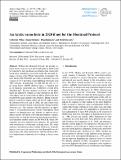| dc.contributor.author | Wilka, Catherine | |
| dc.contributor.author | Solomon, Susan | |
| dc.contributor.author | Kinnison, Doug | |
| dc.contributor.author | Tarasick, David | |
| dc.date.accessioned | 2023-02-28T17:33:20Z | |
| dc.date.available | 2023-02-28T17:33:20Z | |
| dc.date.issued | 2021 | |
| dc.identifier.uri | https://hdl.handle.net/1721.1/148241 | |
| dc.description.abstract | <jats:p>Abstract. Without the Montreal Protocol, the already extreme Arctic ozone losses in the boreal spring of 2020 would be expected to have produced an Antarctic-like ozone hole, based upon simulations performed using the specified dynamics version of the Whole Atmosphere Community Climate Model (SD-WACCM) and using an alternate emission scenario of 3.5 % growth in ozone-depleting substances from 1985 onwards. In particular, we find that the area of total ozone below 220 DU (Dobson units), a standard metric of Antarctic ozone hole size, would have covered about 20 million km2. Record observed local lows of 0.1 ppmv (parts per million by volume) at some altitudes in the lower stratosphere seen by ozonesondes in March 2020 would have reached 0.01, again similar to the Antarctic. Spring ozone depletion would have begun earlier and lasted longer without the Montreal Protocol, and by 2020, the year-round ozone depletion would have begun to dramatically diverge from the observed case. This extreme year also provides an opportunity to test parameterizations of polar stratospheric cloud impacts on denitrification and, thereby, to improve stratospheric models of both the real world and alternate scenarios. In particular, we find that decreasing the parameterized nitric acid trihydrate number density in SD-WACCM, which subsequently increases denitrification, improves the agreement with observations for both nitric acid and ozone. This study reinforces that the historically extreme 2020 Arctic ozone depletion is not cause for concern over the Montreal Protocol's effectiveness but rather demonstrates that the Montreal Protocol indeed merits celebration for avoiding an Arctic ozone hole.</jats:p> | en_US |
| dc.language.iso | en | |
| dc.publisher | Copernicus GmbH | en_US |
| dc.relation.isversionof | 10.5194/ACP-21-15771-2021 | en_US |
| dc.rights | Creative Commons Attribution 4.0 International license | en_US |
| dc.rights.uri | https://creativecommons.org/licenses/by/4.0/ | en_US |
| dc.source | Copernicus Publications | en_US |
| dc.title | An Arctic ozone hole in 2020 if not for the Montreal Protocol | en_US |
| dc.type | Article | en_US |
| dc.identifier.citation | Wilka, Catherine, Solomon, Susan, Kinnison, Doug and Tarasick, David. 2021. "An Arctic ozone hole in 2020 if not for the Montreal Protocol." Atmospheric Chemistry and Physics, 21 (20). | |
| dc.contributor.department | Massachusetts Institute of Technology. Department of Earth, Atmospheric, and Planetary Sciences | en_US |
| dc.relation.journal | Atmospheric Chemistry and Physics | en_US |
| dc.eprint.version | Final published version | en_US |
| dc.type.uri | http://purl.org/eprint/type/JournalArticle | en_US |
| eprint.status | http://purl.org/eprint/status/PeerReviewed | en_US |
| dc.date.updated | 2023-02-28T14:16:20Z | |
| dspace.orderedauthors | Wilka, C; Solomon, S; Kinnison, D; Tarasick, D | en_US |
| dspace.date.submission | 2023-02-28T14:16:22Z | |
| mit.journal.volume | 21 | en_US |
| mit.journal.issue | 20 | en_US |
| mit.license | PUBLISHER_CC | |
| mit.metadata.status | Authority Work and Publication Information Needed | en_US |
